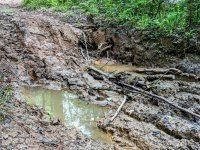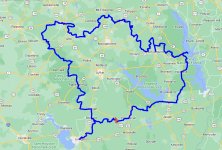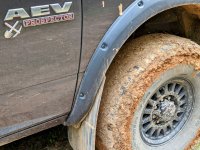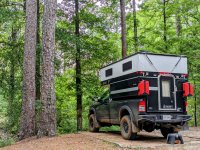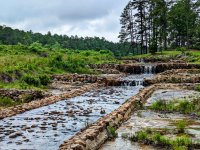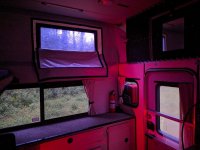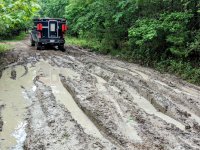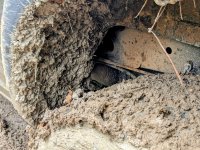Here I am a few hours into beginning my adventure on the
East Texas 450 Loop which passes through three National Forests in east Texas.

As you can see from this first trail picture heading north towards the
Davy Crockett National Forest, east Texas is significantly different when compared to central and south Texas. This has been an absolutely beautiful drive so far. My research has indicated there are some wet areas and with the recent storms I am confident I will see some sloppy and slippery miles.
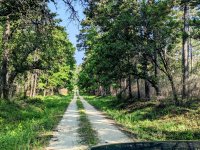
My first night camping deep in the forest alone once again - it has been too long. During the night I listened to a thunder storm roll in from far away. The night was very quiet with no wind for the first few hours. Later on I could hear distant thunder and see flashes of lightening. Then, far away I began to hear the wind roll into the forest like a runaway freight train. As the thunder, lightening, and wind became closer they all became louder and more prominent. Then the rain began and intensified - for the better part of an hour it yelled and screamed and threw everything it could at the forest. Ultimately, the storm passed and everything settled down once again. In the morning I awoke to a quiet and peaceful forest with the birds chirping and the sun struggling to stand tall. It was a new day and I was back where I have always belonged - deep in the forest.
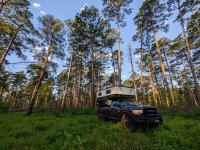
When heavy thunderstorms pass though the forest you can expect mud in areas, and if you hit the trail early, downed trees in others. For those who travel occasionally, looking for an alternate route might be the best option. For those who travel full time, it is best to be prepared to deal with unexpected situations such as this. I carry two handsaws since I generally have unlimited time to clear a path, they never run out of gas, and they are quiet. For nearly a decade I have carried a
Silky BIGBOY 2000 and
Silky GOMBOY 240 folding handsaws which are made in Japan and function very well.

First I clean up the short and long shoots on the trunk since it is generally easier to accomplish before moving the tree. Beware of shoots under load - once you cut through them they quickly release their stored energy. Here I cut one side and then used my
Warn 16.5ti winch and
AEV Full-Size Trail Recovery Kit to move the tree out of the way. One of these days I will decide on which
logging chain choker would be best for me and I will add one to my kit. Another tool I have been considering adding would be an electric chain saw. It seems they have improved over the years and I must sit down to consider if I am willing to forfeit that much room and add the additional weight for something that is infrequently used.

Again, the
East Texas 450 Loop is a beautiful drive with miles of lush green foliage so stop and enjoy if you are nearby.
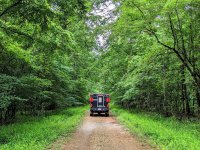
Finding a place to sleep in the
Sabine National Forest proved to be a bit more difficult compared to normal. It's my fault though since I pushed hard during the day, performed little research on where to sleep, and arrived after dark. This is the next morning and to be honest with you - this appears to be a fairly new road cut into the forest where they are installing residential power lines. I was tired and continuing to drive was becoming increasingly dangerous so I located a spot to tuck in and shut down for the night. Early in the morning it was
boots and saddles and I was back on the trail.
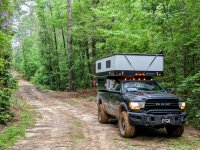
Here is a washed out bridge on Forest Road 111 just south of Hemphill, Texas. When I come upon something unexpected such as this the first thing I do it to slow down the decision making process by parking my rig, making sure the area is safe, and then walking around to take a look at the issue from various angles and consider all the available options. Many people unnecessarily rush to solve a problem only to sometimes select a poor solution or worse yet, compound the problem and make it worse.
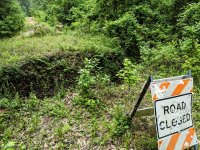
Here is a quick go-around that initially appeared to be an option although following my examination of the nearby trees and trail I decided it was not a good option. The trail was uneven which would place the top of my camper precariously close to trees and might result in damage. The mud was softer than expected - note how the front tire is sinking already.
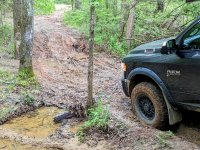
Upon closer examination the opposing side was very slick and the mud and water hole were filled with many short sticks that were apparently thrown in to increase traction. I am not a fan of sticks since I have experienced damage from them in the distant past. I saw a picture once of a longer stick that penetrated the firewall on a Jeep and went right into the drivers seat - while the driver was driving down a dark trail at night. After considering my options I opted for backtracking a few miles, jumping on a parallel paved road, and driving around the washed out bridge. It may have taken an additional twenty minutes but it was the safest option and I have nothing to prove regarding my off-road ability. Yes, I could have waded into the mud to clear the sticks and winched my way through possibly damaging my trail but why when there is a better option do nearby?
